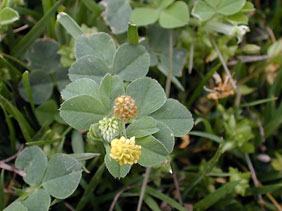BLACK MEDIC
|
 |
| File Size: 56 KB |
|
|
|
Medicago lupulina L.
|
| Riley County, Kansas |
| Annual |
| Height: Prostrate |
| Family: Fabaceae - Bean Family |
| Flowering Period: May, June, July, August, September |
|
| Also Called: | | Black medick, yellow trefoil. | | Stems: | | Prostrate or ascending, often much branched at base, 2 to 32 inches long, nearly smooth to soft- or finely-hairy. | | Leaves: | | Alternate, pinnately 3-foliolate; stalks up to 1.2 inches long; stipules lanceolate to ovate, entire or toothed, united to stalk for 1/4 to 1/2 of length; leaflets elliptic, egg-shaped, rhombic, or oblong wedge-shaped, 1/5 to 4/5 inch long, sparsely to densely hairy, margins minutely toothed in upper 1/2, tips rounded to notched and usually with short, abrupt points | | Inflorescences: | | Racemes, 8- to 50-flowered, spherical to short-cylindric, 1/4 to 2/5 inch long, on stalks 1-4 times longer than leaves. | | Flowers: | | Papilionaceous, about 1/10 inch long, yellow or cream; stamens 10, in 2 groups. | | Fruits: | | Pods, less than 1/8 inch long, curved, kidney-shaped, black at maturity; seed 1, 1/12 inch long, olive, brown or black. | | Habitat: | | Lawns, waste places, roadsides, stream valleys, pastures, fields, and prairie ravines. | | Distribution: | | Principally east 2/3 of Kansas. | | Origin: | | Introduced from Eurasia, now naturalized. | | Reproduction: | | The seeds can remain viable in the soil for years. | | Forage Value: | | Black medic is palatable to livestock and has fair forage value, but is generally not considered a good forage. Will cause bloat if over-consumed. | | Uses: | | Deer eat the leaves, and game birds the seeds. Sometimes planted for soil improvement. | | Comments: | | Black medic can be a problem weed in lawns. |
|
| Black medic |  | | 90 KB | | Riley County, Kansas |
| | Black medic |  | | 95 KB | | Mitchell County, Kansas |
| | Black medic |  | | 144 KB | | Konza Prairie, Riley County, Kansas |
| | Black medic |  | | 128 KB | | Konza Prairie, Riley County, Kansas |
| | Black medic pubescence |  | | 121 KB | | Konza Prairie, Riley County, Kansas |
| | Black medic habit |  | | 309 KB | | Konza Prairie, Riley County, Kansas |
| | Black medic inflorescences |  | | 217 KB | | Leavenworth County, Kansas |
| | | |
|
|
|
|
|
|